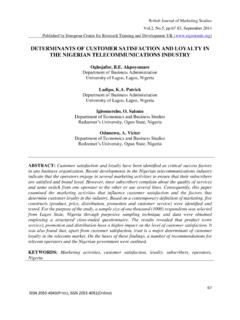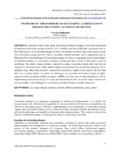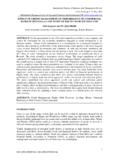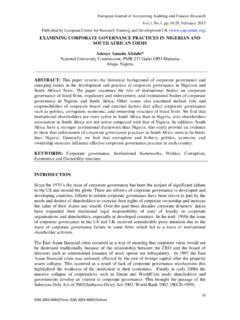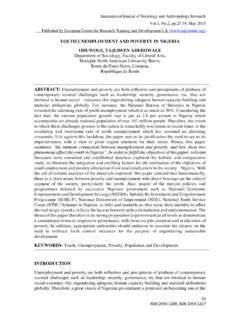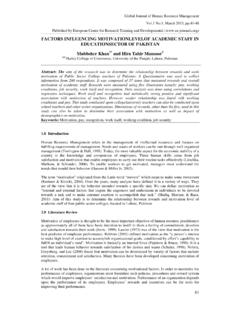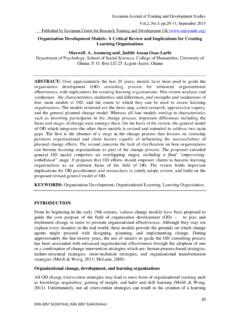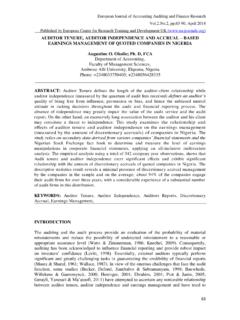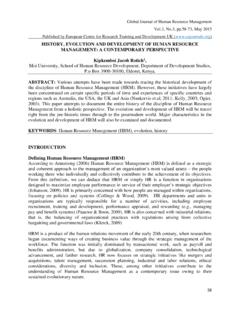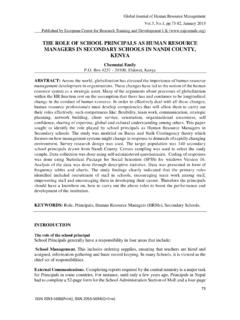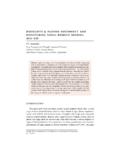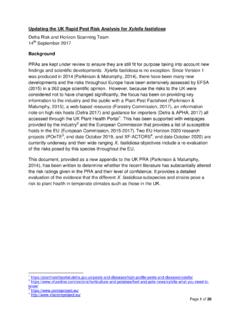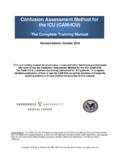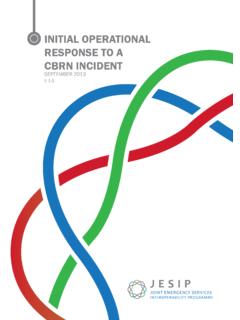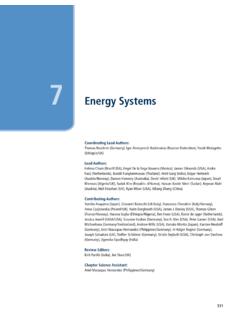Transcription of RISK BASED INTERNAL AUDITING AND RISK …
1 European Journal of Accounting AUDITING and Fianance Research , , , September 2014. Published by European Centre for Research Training and Development UK( ). RISK BASED INTERNAL AUDITING AND RISK ASSESSMENT PROCESS. Ferhan Benli1( Assistant Prof). stanbul Commerce University, Banking and Finance Department Duygu Celayir2.(Research Assistant). Istanbul Commerce University, Accounting and AUDITING Department. ABSTRACT: Financial crisis that emerged in the international markets and accounting abuses as Enron, Worldcom in the that brought out the need of detection of the risks that organisations will encounter in the future and the management of these risks. Organisations to use risk management as an auxiliary tool in order to reach the stated targets raised management' expectation about adding value of INTERNAL AUDITING .
2 Risk BASED INTERNAL AUDITING which is the present latest stage of INTERNAL AUDITING and which brings to create achievement that having expected from INTERNAL AUDITING place the retrospective point of view the conventional control mentality on one side and had focused on risks that organisations will encounter. As to achieve succeess in the risk BASED INTERNAL AUDITING is possible with an effective risk assessment studies performed within this period. Risk findings obtained as a result of risk assessment studies constitute an important support to INTERNAL auditors at the stage designing of plannimg. In this study, risk BASED INTERNAL AUDITING which constitutes of today's INTERNAL AUDITING mentality is tried to explained and risk assessment studies which are this process' the most important stage has been considered within the scope of INTERNAL AUDITING units performed studies.
3 KEYWORDS: INTERNAL AUDITING , Risk Management, Risk BASED INTERNAL AUDITING , Assessment of Risk INTRODUCTION. Perspectives of organisations to the risk in today's dynamic competitive environment have changed with globalization and now, taking advantage of the returns of risky activities has become one of the priorities of organisations. However, the global economic crisis required that risks are managed by the organisations. These developments revealed the AUDITING of risky activities incurred by organisations, in other words, the risk- BASED INTERNAL AUDITING (RBIA) approach. RBIA approach is separated from the other INTERNAL audit approaches with its features such as focusing on fields exposed to high risk rather than the financial field and creating much value. Risk- BASED INTERNAL AUDITING selects the high-risk fields determined by risk assessment as a focal point and provides time and cost saving in the audit.
4 Now, INTERNAL auditors do not only supervise the control activities, but also contribute to the development of the risk management processes by defining the universe of risks and continuously monitor the 1. European Journal of Accounting AUDITING and Fianance Research , , , September 2014. Published by European Centre for Research Training and Development UK( ). risk status of business. (Lindow and Race, 2002). RBIA orientation to the future's risks is the main difference between this new model of audit and the traditional one that looks backwards, presenting to the entity's management only the past risks. RBIA improves the economic activities providing the maximum of efficiency. (Danescu, Muntean and Sandru, 2010). The purpose of the study is to describe the changing nature and the last point of INTERNAL audit with general lines and to discuss how the risks are identified and measured and how the risk- BASED INTERNAL AUDITING plan is affected from this assessment by examining risk assessment study which is the most important stage of this progress.
5 In addition, assessment regarding the implementation of the RBIA in organisations was made as an example LITERATURE REVIEW. Risk BASED INTERNAL AUDITING : Conceptual Framework In recent years, obstacles on the free movement of capital gradually decreased with increasing global developments and financial mobility has increased with help of its interaction and the convergence of markets . Presence of multinational companies parallel to the emergence of technological developments as a gripping force has further hardened the competition. Achieving a sustainable competitive advantage for the businesses has become dependent on eliminating the negative effects of risks occurring in this changing environment. All these developments and especially developments after the important corporate scandals in the world have necessitated the risk management in terms of organisations andhave made the role of INTERNAL AUDITING in this process more prominent.
6 In this context, assessing the organisation risks by determining risk management and risk- BASED AUDITING understanding and managing it in a good way have become imperative. In parallel with all these transformations, INTERNAL audit has moved through risk management, corporate governance and Risk BASED approach BASED on adding value from the control-oriented approach. In other words, audit approach assessing business risks provided the auditors in the audit process to go to the change and these changes have brought a Risk BASED approach in INTERNAL audit practices today,.The risks that have low, medium and high effect can exist at the beginning and until the end of an audit process. If these risks materialize, this shall affect the operation of process and the quality of the control.
7 Identification and assessment of these risks in the audit process and removing the present audit deficiencies or development of new controls will improve the quality of audit activities. (Ozaydin, 2010). Risk BASED INTERNAL AUDITING (RBIA) is the methodology which provides assurance that risks are being managed to within the organisation's risk appetite.(IIA). 2. European Journal of Accounting AUDITING and Fianance Research , , , September 2014. Published by European Centre for Research Training and Development UK( ). Three major developments on RBIA can be listed as below. (Ozsoy, 2004). Technological developments with financial theory and practices have widened the scope of business activities. The diversity seen in the derivatives markets along with the popularization of derivative products and other complex structured financial products has dramatically changed the financial system.
8 The consolidation of the banking industry from the 1990s has led to the emergence of an increasing number of large banks. Therefore, banking resources has intensified in fewer and larger banks. RBIA was applied firstly in the banking sector together with these development and it began to be implemented in other sectors. These developments dramatically change the risk characteristics of businesses and brought a rapid change in the risk profile. INTERNAL audit formerly referred to error examination and studies on a specific activity, and today, it emphasises on better management in the future rateher than the assessment of past activities of businesses with the Risk BASED approach. (Keskin, 2010) Developments in markets, corporate bankrupties (Enron, Parmalat, etc.), developing technology and business environments at the beginning of the 2000s showed that many risks are faced to achieve the objectives.
9 With the development of risk management and risk management models, the necessity for consideration of the risks in the INTERNAL audit processes has emerged. With Risk BASED approach in INTERNAL AUDITING , auditors began allocating the resources to high-risk areas and performing audits. Thus, the INTERNAL AUDITING has undergone a drastic change in the 2000s. RBIA is to concentrate the audit resources to the areas where the composition of probability of occurrence and impact of risk is highest. The important point is to identify the business risks. If the risks are not identified and assessed, then the INTERNAL auditor is required to cooperate with business management to provide information on this subject. ( , 2005). RBIA is an audit approach on the basis of determining the risk profiles of the businesses, shaping the audit progress according to the risk profile of the business and allocating the audit resources according to this profile to improve the efficiency of the audit (Keskin, 2010).
10 RBIA selects the high-risk fields as focal points in audit by using the outputs of risk management processes. Thereby the efficiency in audit is increased and cost and time savings are provided (Kishali and Pehlivanli, 2006). The aforementioned approach also brings some assumption. (Baspinar, 2006). Some of these assumptions are as follows;. Audit resources are not unlimited. Unit activities to be audited are faced with different risks. Risks have relatively different degrees of importance. 3. European Journal of Accounting AUDITING and Fianance Research , , , September 2014. Published by European Centre for Research Training and Development UK( ). Primarily the risk status will be discovered on RBIA and issues such as scope, content, timing of INTERNAL audit activities and the allocation of resources are shaped according to the risk status.
